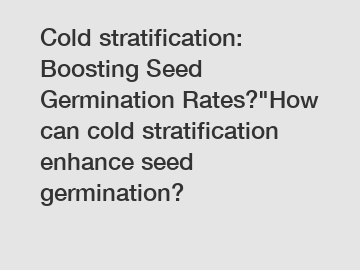Jan. 19, 2024
Agriculture
Link to Dayu
When it comes to growing plants from seeds, sometimes nature needs a helping hand. Cold stratification is a natural technique that gardeners have been employing for centuries to enhance seed germination rates. This unique process mimics the conditions required by certain seeds to break dormancy and thus encourages successful sprouting. In this blog post, we will delve into the fascinating world of cold stratification, exploring how it enhances seed germination and why it is a go-to method for gardeners seeking optimal results.
What is Cold Stratification?

Cold stratification is the process of simulating winter conditions for certain seeds, usually those originating from temperate or colder regions. These seeds have evolved in such a way that their germination is triggered only after a period of chilling. This natural mechanism ensures that the seeds lay dormant during unfavorable conditions and germinate when environmental factors are more favorable for growth.
The Benefits of Cold Stratification:
1. Breaking Seed Dormancy: Cold stratification is particularly useful for seeds that have a hard outer shell or a tough seed coat. By exposing the seeds to a chilling period, the seed coat is weakened, making it easier for water and oxygen to penetrate the seed and initiate germination. This process can significantly increase germination success rates for such seeds.
2. Stimulating Enzymatic Activity: During cold stratification, enzymes within the seeds become activated and start breaking down inhibitors that hinder germination. These inhibitors may be naturally occurring chemicals or hormones that prevent the seed from sprouting in unsuitable conditions. As the chilling period progresses, these inhibitors are neutralized, allowing the seed to awaken from its dormant state and begin germination when planted in favorable conditions.
3. Enhancing Uniform Germination: Certain plant species may exhibit uneven germination rates when not subjected to cold stratification. By mimicking the natural cold period, gardeners can synchronize germination, ensuring a higher success rate and a more uniform growth pattern among the seeds.
Cold Stratification Techniques:
1. Refrigerator Method: One of the simplest methods for cold stratification involves sealing the seeds in a plastic bag with a moistened substrate, such as vermiculite or paper towel. This bag is then placed into the refrigerator at a temperature between 32-41 degrees Fahrenheit (0-5 degrees Celsius) for a specific duration, varying depending on the seed type. It's important to avoid freezing the seeds, which can damage them.
2. Winter Sowing: Winter sowing is a popular cold stratification technique that involves sowing the seeds directly into containers or outdoor beds during the fall or winter season. The seeds experience natural fluctuations in temperature as the seasons progress, eventually stratifying when exposed to colder temperatures. This method is advantageous as it requires minimal intervention but still yields good results.
3. Outdoor Stratification: For larger seeds or species that require prolonged periods of cold stratification, such as some tree seeds, outdoor stratification can be a suitable approach. Seeds can be sown directly into prepared soil in late fall, covered with a protective layer, and left to go through winter naturally.
Conclusion:
When seeds seem slow to germinate or exhibit inconsistent sprouting rates, cold stratification can be an invaluable solution. By subjecting certain seeds to a chilling period, we enable them to break dormancy and reach their full potential in optimal growing conditions. Properly employing cold stratification techniques can significantly boost seed germination rates, ensuring a successful and fruitful gardening experience. So, next time you encounter a seed with specific cold stratification requirements, embrace this natural process and witness the magic of enhanced germination firsthand!
Please visit our website for more information on this topic.
For more information, please visit red pearl tomatoes manufacturer.
Next: Is walnut fruit edible?
If you are interested in sending in a Guest Blogger Submission,welcome to write for us!
All Comments ( 0 )